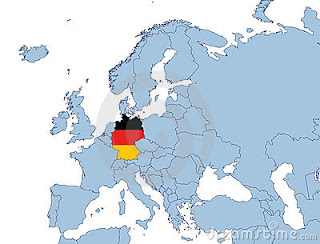Hi everyone! How are you doing? We are fine, our trip is going to an end now, so we are a little bit sad that we have to go home soon. But I am also a little bit excited because I really missed my home and family!
So, arrived at Germany. I am going to tell you something more about the geography from Germany, its inhabitants, surface etc. We arrived a few days ago, but we had a lot of meetings and a few conferences planned, so I actually did not have the time to keep you informed about our trip.
We landed in Berlin, which is the capital and at the same time the biggest city in Germany. If you were not in Europe before and you cannot visualize the country; it is placed in western and central Europe and borders Denmark, Poland, the Czech Republic, Austria, Switzerland, France, Luxembourg, Belgium and the Netherlands. Germany borders the North sea and the Baltic sea and has a coastline of 2389 kilometres . Germany is the 62nd largest country in the world, so you can imagine that Germany has a large surface and a lot of inhabitants. Its exact numbers are 357.021 square kilometres and 81.8 million inhabitants which makes Germany the most populous member state in the European Union.
Germany is divided into three important geographic areas: the German “Lowland” in the north, the central German highlands and the Alps in the south. The whole country is divided into 16 federal states.
The largest part in Germany has a temperate seasonal climate. In the north and northwest of the country, the climate is oceanic. Its winters are mild and summers are mostly warm with temperatures that can occur till 30°C . Germans expect rain year-round, with no obligatory dry season. The east and south of the country have a more continental climate. Its winters can be very cold with a lot of snowfall and summers very warm and in that part of the country it is dryer. Germans who live in the Alps have a mountain climate, which means that they have lower temperatures and greater rainfall. This is the weather at this moment in Berlin:
The most important and largest cities in Germany are:
- Berlin with 3.460.725 inhabitants;
- Hamburg with 1.786.448 inhabitants;
- München with 1.353.186 inhabitants;
- And last but not least Köln with 1.007.119 inhabitants.
There are a lot of places you can visit in Germany, think about the famous Berlin wall, Alexanderplatz in Berlin, the Brandenburger Tor in Berlin, the Marienplatz in München, the Olympic park in München, etc. But my colleagues are going to inform you more about the many curiosities in Germany, so do not worry!
So, I guess I will talk to you next week, for the last time when we are in Norway, our final destination. I hope you enjoyed our blog until now!
Liesbeth
Sources:
Three relevant real-life examples:




No comments:
Post a Comment